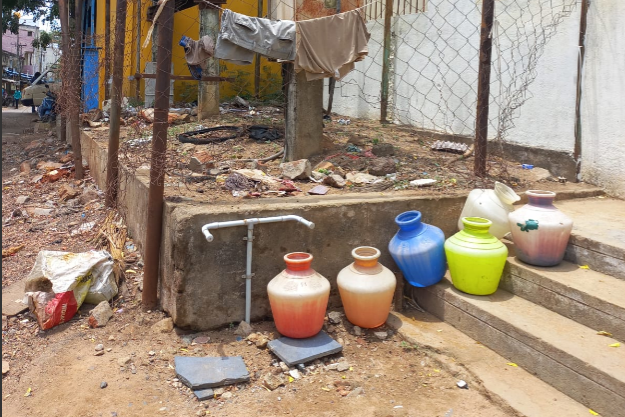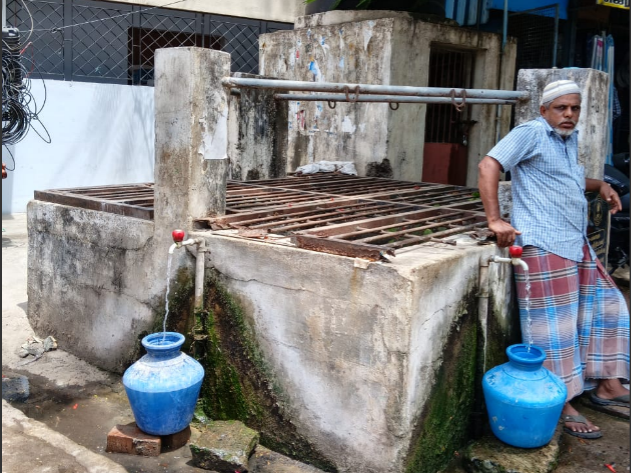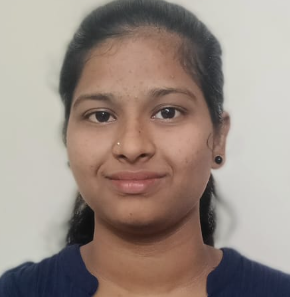AQUAMITRA: 𝗘𝗺𝗽𝗼𝘄𝗲𝗿𝗶𝗻𝗴 𝗘𝘃𝗲𝗿𝘆 𝗗𝗿𝗼𝗽, 𝗘𝘃𝗲𝗿𝘆 𝗛𝗼𝗺𝗲.
Imagine waking up before dawn, racing to the end of the street with empty buckets, only to find a dry tap—or worse, a crowd of neighbors arguing over who was first. In India’s rural belts and even in parts of our cities, this is not fiction—it’s daily life.
The Gaps and the Ground Realities
Water scarcity in India is not just an environmental concern—it’s a daily struggle for millions. From the dry hinterlands of rural villages to overcrowded urban streets, the country faces a deeply fractured water distribution system. In many rural regions, people rely entirely on borewells, often without any form of treatment, risking their health due to contaminated sources. In urban India, despite advanced pipelines and water treatment facilities, challenges such as unequal access, water theft, damaged infrastructure, and unpredictable supply continue to plague communities. Water tankers often serve as backup, yet they arrive sporadically and with questionable hygiene. While water meters exist in many households, they remain non-functional or unmonitored, making equitable allocation almost impossible. Overall, whether it’s a bustling metro or a quiet village, the problems remain: erratic supply, quality concerns, and lack of fairness.
To truly understand the depth and diversity of these challenges, we moved beyond secondary data and policy reports—into the field. Through direct engagement with communities, observation of local practices, and assessment of existing infrastructure, our field research provided critical insights into the lived realities of water access in both rural and urban settings.

A Tale from the Field
Our field research reveals a stark contrast between rural and urban water infrastructure in India. In rural areas, water supply is fragmented and unreliable. Communities depend heavily on borewells, with shared pipelines often serving up to 10 households. Water is available for just 1–2 hours daily, with no treatment or filtration—posing serious health risks. Water from reservoirs is treated and pumped through structured pipelines to most households. However, issues like damaged infrastructure, water theft, and non-functional meters persist.
In areas like Old Pallavaram and Kotturpuram (Chennai) we noted that although metro water is supplied, the timing is unpredictable. Some households have water meters, but these are not implemented. While certain areas receive both metro and bore water, adjacent streets may get no water at all and must rely on tankers. This uneven distribution causes frustration and affects daily routines. A key insight was gathered from Malaimedu, a locality near Pallavaram, Chennai. A single central water tank supplies four densely populated areas. This tank has a total storage capacity of 8 lakh litres—5 lakh litres in the overhead tank and 3 lakh litres in a ground-level sump. Water is chlorinated and treated for seven hours before distribution. Despite the tank’s large capacity, the entire supply is distributed within a tight 1.5-hour window, and only once every day, serving nearly 20,000 residents.
However, serious challenges persist. Each cluster of about 20 households shares a single common pipeline, forcing residents to gather quickly during the limited supply window to collect enough water for the entire day. This often results in long queues, crowding, and time-bound pressure, especially impacting women, elderly people, and daily-wage workers.

What is AQUAMITRA?
*This video Contains AI generated clips
To address the pressing challenges of water scarcity, inequitable access, and daily collection stress, we propose the implementation of a Smart Water Card System, seamlessly integrated with existing ration cards. This system ensures each household receives a daily water quota based on family size, accessible 24×7 through a card-tap mechanism. Instead of rushing during limited supply windows, residents can collect their allocated water at their convenience, significantly reducing crowding, wastage, and conflict.
Smart tap units will be installed across neighborhoods and shared community points. These units will track water usage digitally, promoting accountability and responsible consumption.
To accommodate temporary surges in water demand—such as during festivals, family gatherings, or emergencies—the system introduces a Water Loan Feature. Residents can request additional water beyond their daily quota by calling a dedicated IVR (Interactive Voice Response) number, which verifies their identity and allocates excess water accordingly. This ensures flexibility without compromising overall sustainability.

Key Feature
- Smart Water Cards: Each household gets a card linked to its ration card and family size. The card grants access to a daily water quota.
- Tap Anytime: No more early morning rush. Smart dispensing units allow 24×7 access, removing the stress of fixed supply windows.
- Fair Quotas: Quotas are assigned based on headcount, ensuring every individual gets what they need.
- Usage-Based Costing: Households pay based on usage. The first basic quota may be free or low-cost. Extra usage comes at a fee, encouraging conservation and fairness.
- Real-Time Monitoring: Data from each tap helps monitor usage patterns, detect misuse, and plan supply better.
- Sustainability at Core: Solar-powered dispensers, IoT water-quality sensors, and automated alerts bring eco-consciousness to the forefront.
- Water Loan System: During festivals, gatherings, or emergencies, families can request additional water beyond their daily quota. Just call the dedicated IVR number to verify identity and get temporary quota boosts.


HOW DOES IT WORK?

Aquamitra’s smart flow brings together technology and simplicity. Each tap connects to the cloud, tracking how much water is drawn, when, and by whom — all through an easy tap of the Smart Water Card.
To make this smarter, Aquamitra links with existing government databases. Every household’s details are verified through their ration card, ensuring fair quotas and genuine access. The data connection also makes the system automatically scalable — from one village to an entire city — without manual setup or re-registration
Feasibility and Viability
The AquaMitra Smart Water Card System is both technically feasible and socially viable for rural and semi-urban water management.
1.Technical Feasibility:
The system uses affordable IoT components such as RFID cards, flow sensors, and low-cost controllers — all easy to install, maintain, and scale. It runs on solar or grid power, ensuring continuous operation even during power cuts.
2.Economic Feasibility:
With an estimated setup cost of around ₹10,000–₹12,000 per dispenser and ₹30–₹50 per smart card, the project remains low-cost and sustainable. Reduced wastage and automated control help recover costs within 1–2 years.
3.Operational Feasibility:
The simple “tap-and-fill” process allows any household to use it easily. Local operators can manage the system with minimal training and basic tools.
4.Social Viability:
Communities welcome the solution as it ensures fair access, reduces water-related disputes, and builds trust through transparency.
5.Environmental Viability:
Controlled dispensing minimizes wastage and encourages responsible water use, making AquaMitra eco-friendly and future-ready.
Sustainability

OUR VISION
Aquamitra aims to make clean water accessible to every household, fairly and efficiently. We use smart card-based systems to ensure accountable and need-based water usage. Our goal is to support communities with a simple, transparent, and sustainable solution.
STAKEHOLDERS

IMPACT

FUTURE SCOPE
- AI-Powered Demand Forecasting: Use AI/ML models to predict water demand surges (festivals, summer, migration patterns) and adjust supply proactively.
2. Smart Leak Detection & Preventive Maintenance: IoT-enabled pipelines with real-time leak alerts and automated maintenance scheduling.
3. Water Credits and Subsidy Management:
Introduce water credit systems, enabling households to carry forward unused quotas or receive subsidies based on responsible usage.
4. Mobile App & Multilingual IVR Integration: Develop an intuitive mobile platform and expand IVR support in regional languages for easier access, complaints, and on-demand requests.



